How to use the MODE.MULT function
What is the MODE.MULT function?
The MODE.MULT function calculates the most frequent number in a cell range. It will return multiple numbers if they are equally frequent. Text and boolean values are ignored.
The MODE.MULT function is entered as an array formula in Excel versions prior to Excel 365. Enter the function as a regular function in Excel 365, it will spill values to cells below if needed.
How to enter the function as an array formula?
- Double press with left mouse button on the cell where you want to enter the formula.
- Enter the function, for example: =MODE.MULT(B3:B10)
- Press and hold CTRL + SHIFT.
- Press Enter once.
- Release all keyboard keys.
The formula is now enclosed with curly brackets, like this: {=MODE.MULT(B3:B10)}
Don't enter these characters yourself, they appear automatically.
Table of Contents
1. Introduction
What is the mode or modal in statistics?
The mode or modal is the most frequent value in a given data set.
Why calculate the most frequent value (mode or modal)?
It condenses a whole set of data into one value that indicates the center of its distribution. It is useful for describing categorical data such as the most popular ice-cream, company, or group. The mode value may also describe the symmetry of numerical data.
Th most used measures that indicate the center of its distribution are AVERAGE, MEDIAN and MODE or modal. The AVERAGE function calculates the arithmetic mean, the MEDIAN function extracts the middle number, and the MODE.MULT function returns the most repeated number(s) in a distribution.
Other measures that indicate the center of its distribution are the harmonic mean (HARMEAN function) and the geometric mean (GEOMEAN function). They are less common but important to know about.
How can you interpret the mode in relation to the mean and median?
The mode can be interpreted in relation to the mean and median to describe the shape and symmetry of a distribution.
When a group of numbers is symmetrical, the mean, median and mode are equal. They vary if the distribution is skewed.
For a skewed distribution (SKEW function), the mode is located at the peak of the distribution, while the mean is pulled towards the tail of the distribution. The median is usually between the mean and the mode but not always.
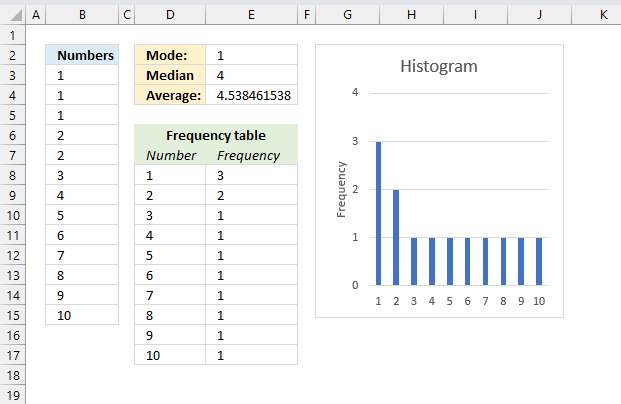
This distribution shown in the image above is positively skewed or right-skewed because it has a long right tail. The mode is 1, the median is 4, and the mean is approx. 4.54. The mean is greater than the median and the mode. This is because the mean is influenced by the extreme values in the right tail of the distribution, such as 7, 8, 9 and 10.
What is the difference between the MODE.SNGL, MODE.MULT, and the MODE functions?
The MODE function is a legacy function, it may be removed any time without any notice according to Microsoft. This function is deprecated and should not be used. It is only maintained for backward compatibility.
Both the MODE.SNGL and MODE.MULT functions return the most frequent value, however, the MODE.MULT function returns multiple values if they are equally frequent.
Can the MODE.MULT function extract the most common text value?
No, it ignores text and boolean values. There is a workaround, see section 6 below.
2. MODE.MULT Syntax
MODE.MULT((number1,[number2],...)
3. MODE.MULT Function Arguments
| number1 | Required. A number or reference for which you want to calculate the MODE for. |
| [number2] | Optional. Up to 254 additional arguments. |
4. MODE.MULT Function Example
The MODE.MULT function demonstrated in the picture above returns both 2 and 4. Both 2 and 4 exist 3 times each in cell range B3:B10. These values are the most frequent values.
Formula in cell D3:
The formula in cell D3 returns 2 numbers, Excel 365 spills values to cells below as far as needed, however, earlier Excel versions require you to enter the formula as an array formula. Instructions on how to enter a formula as an array formula are at the top of this article.
A frequency table shows how many times each value occurs in a given data set. Here is how to create a frequency table in Excel 365:
4.1 How to create a frequency table based on numerical values
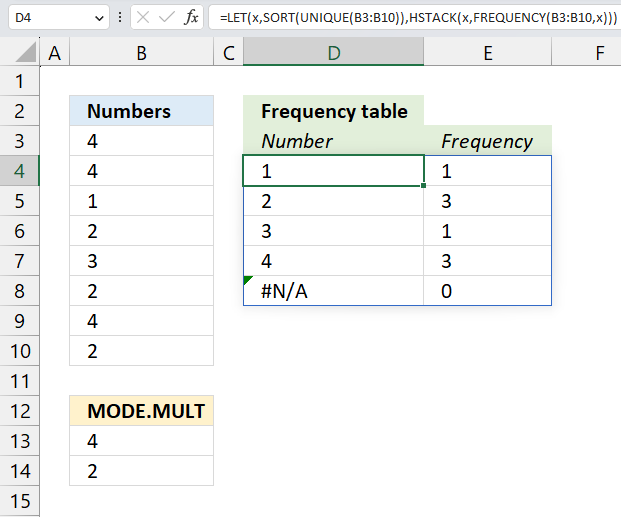
The formula in cell D4 creates a frequency table based on the data set specified in cell range B3:B10. The output values spills to cells below and to the right as far as needed.
The frequency table shows that numbers 2 and 4 are the most frequent values in cell range B3:B10, they also match the output from the MODE.MULT function.
Excel 365 formula in cell D4:
Remove last row
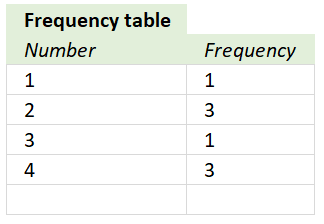
The FREQUENCY function returns an array larger than the argument array, this creates a #N/A error in the output. Use the DROP function to remove the last row if needed. Here is how:
Sort table by frequency
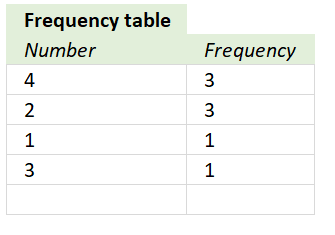
The output is sorted based on the numbers from small to large, to sort by frequency use this formula:
This sorts the output by the second column from large to small.
Explaining formula in cell D4
The Evaluate Formula tool is located on the Formulas tab in the Ribbon. It is a useful feature that allows you to step through and evaluate complex formulas to understand how the calculation is being performed and identify any errors or issues. The following steps shows these detailed evaluations for the formula above.
Step 1 - Extract unique distinct numbers
The UNIQUE function returns a unique or unique distinct list.
Function syntax: UNIQUE(array,[by_col],[exactly_once])
UNIQUE(B3:B10)
becomes
UNIQUE({4;4;1;2;3;2;4;2})
and returns
{4;1;2;3;}
Step 2 - Sort numbers from small to large
The SORT function sorts values from a cell range or array
Function syntax: SORT(array,[sort_index],[sort_order],[by_col])
SORT(UNIQUE(B3:B10))
becomes
SORT({4;1;2;3;})
and returns
{1;2;3;4}
Step 3 - Calculate frequency
The FREQUENCY function calculates how often values occur within a range of values and then returns a vertical array of numbers.
Function syntax: FREQUENCY(data_array, bins_array)
FREQUENCY(B3:B10,SORT(UNIQUE(B3:B10)))
becomes
FREQUENCY({4;4;1;2;3;2;4;2},{1;2;3;4})
and returns
{1;3;1;3;0}
Step 4 - Stack arrays horizontally
The HSTACK function combines cell ranges or arrays. Joins data to the first blank cell to the right of a cell range or array (horizontal stacking)
Function syntax: HSTACK(array1,[array2],...)
HSTACK(SORT(UNIQUE(B3:B10)),FREQUENCY(B3:B10,SORT(UNIQUE(B3:B10))))
becomes
HSTACK({1;2;3;4},{1;3;1;3;0})
and returns
{1,1;2,3;3,1;4,3;#N/A,0}
Step 5 - Shorten the formula
The LET function lets you name intermediate calculation results which can shorten formulas considerably and improve performance.
Function syntax: LET(name1, name_value1, calculation_or_name2, [name_value2, calculation_or_name3...])
HSTACK(SORT(UNIQUE(B3:B10)),FREQUENCY(B3:B10,SORT(UNIQUE(B3:B10))))
SORT(UNIQUE(B3:B10)) is repeated twice in the formula.
x- SORT(UNIQUE(B3:B10))
LET(x,SORT(UNIQUE(B3:B10)),HSTACK(x,FREQUENCY(B3:B10,x)))
5. How can you test if a data set has a unique mode or multiple modes?
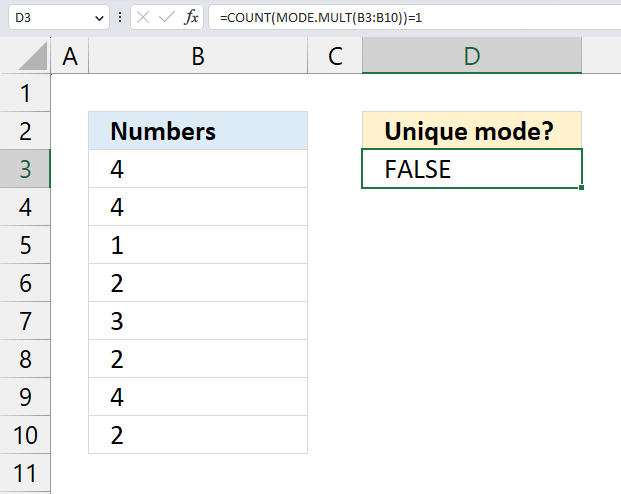
The manual way to check if a distribution has a unique mode is to create a frequency table, however, the MODE.MULT returns multiple values if multiple modes exist.
The formula in cell D3 tests if a given distribution has a unique mode or multiple modes. It returns TRUE if the data set has a unique mode and FALSE if multiple modes exist.
Cell range B2:B10 contains example data which are displayed in the image above, the cell range has the following values:
| Numbers |
| 4 |
| 4 |
| 1 |
| 2 |
| 3 |
| 2 |
| 4 |
| 2 |
The most frequent value in B3:B10 is 2 and 4 which both exists three times each. The MODE.MULT function returns two values.
Formula in cell D3:
The formula returns FALSE because the B3:B10 has not a unique mode but two modes.
Explaining formula in cell D3
The Evaluate Formula tool is located on the Formulas tab in the Ribbon. It is a useful feature that allows you to step through and evaluate complex formulas to understand how the calculation is being performed and identify any errors or issues. The following steps shows these detailed evaluations for the formula above.
Step 1 - Calculate most frequent value
The MODE.MULT function returns the most frequent number in a cell range. It will return multiple numbers if they are equally frequent.
Function syntax: MODE.MULT((number1,[number2],...)
MODE.MULT(B3:B10)
becomes
MODE.MULT({4;4;1;2;3;2;4;2})
and returns {4;2}.
Step 2 - Count values
The COUNT function counts all numerical values in an argument.
Function syntax: COUNT(value1, [value2], ...)
COUNT(MODE.MULT(B3:B10))
becomes
COUNT({4;2})
and returns 2.
Step 3 - Check if count is equal to 1
The equal sign is a logical operator that lets you test if an expression meets a condition, it returns boolean value TRUE or FALSE.
COUNT(MODE.MULT(B3:B10))=1
becomes
2=1
and returns FALSE.
6. Function not working
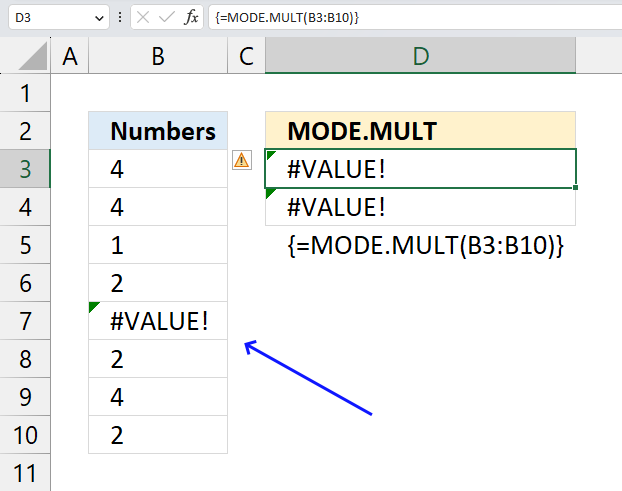
This example shows that the MODE.MULT function returns an error if the source data contains an error. This means that the MODE.MULT function can't handle errors, you have to find the errors and deal with them.
The IFERROR function lets you ignore error values. Here is an example that solves the problem shown in the image above:
This converts errors to blank values "" which the MODE.MULT function ignores.
How to find errors in a worksheet
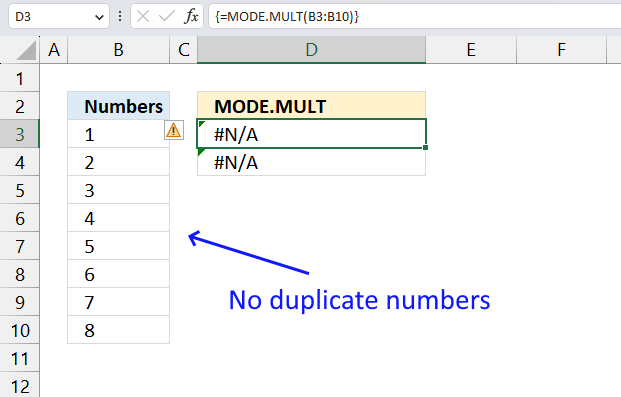
The MODE.MULT function also returns an error if there are no duplicate numbers in the source data set.
6.1 Troubleshooting the error value

When you encounter an error value in a cell a warning symbol appears, displayed in the image above. Press with mouse on it to see a pop-up menu that lets you get more information about the error.
- The first line describes the error if you press with left mouse button on it.
- The second line opens a pane that explains the error in greater detail.
- The third line takes you to the "Evaluate Formula" tool, a dialog box appears allowing you to examine the formula in greater detail.
- This line lets you ignore the error value meaning the warning icon disappears, however, the error is still in the cell.
- The fifth line lets you edit the formula in the Formula bar.
- The sixth line opens the Excel settings so you can adjust the Error Checking Options.
Here are a few of the most common Excel errors you may encounter.
#NULL error - This error occurs most often if you by mistake use a space character in a formula where it shouldn't be. Excel interprets a space character as an intersection operator. If the ranges don't intersect an #NULL error is returned. The #NULL! error occurs when a formula attempts to calculate the intersection of two ranges that do not actually intersect. This can happen when the wrong range operator is used in the formula, or when the intersection operator (represented by a space character) is used between two ranges that do not overlap. To fix this error double check that the ranges referenced in the formula that use the intersection operator actually have cells in common.
#SPILL error - The #SPILL! error occurs only in version Excel 365 and is caused by a dynamic array being to large, meaning there are cells below and/or to the right that are not empty. This prevents the dynamic array formula expanding into new empty cells.
#DIV/0 error - This error happens if you try to divide a number by 0 (zero) or a value that equates to zero which is not possible mathematically.
#VALUE error - The #VALUE error occurs when a formula has a value that is of the wrong data type. Such as text where a number is expected or when dates are evaluated as text.
#REF error - The #REF error happens when a cell reference is invalid. This can happen if a cell is deleted that is referenced by a formula.
#NAME error - The #NAME error happens if you misspelled a function or a named range.
#NUM error - The #NUM error shows up when you try to use invalid numeric values in formulas, like square root of a negative number.
#N/A error - The #N/A error happens when a value is not available for a formula or found in a given cell range, for example in the VLOOKUP or MATCH functions.
#GETTING_DATA error - The #GETTING_DATA error shows while external sources are loading, this can indicate a delay in fetching the data or that the external source is unavailable right now.
6.2 The formula returns an unexpected value

To understand why a formula returns an unexpected value we need to examine the calculations steps in detail. Luckily, Excel has a tool that is really handy in these situations. Here is how to troubleshoot a formula:
- Select the cell containing the formula you want to examine in detail.
- Go to tab “Formulas” on the ribbon.
- Press with left mouse button on "Evaluate Formula" button. A dialog box appears.
The formula appears in a white field inside the dialog box. Underlined expressions are calculations being processed in the next step. The italicized expression is the most recent result. The buttons at the bottom of the dialog box allows you to evaluate the formula in smaller calculations which you control. - Press with left mouse button on the "Evaluate" button located at the bottom of the dialog box to process the underlined expression.
- Repeat pressing the "Evaluate" button until you have seen all calculations step by step. This allows you to examine the formula in greater detail and hopefully find the culprit.
- Press "Close" button to dismiss the dialog box.

There is also another way to debug formulas using the function key F9. F9 is especially useful if you have a feeling that a specific part of the formula is the issue, this makes it faster than the "Evaluate Formula" tool since you don't need to go through all calculations to find the issue.
- Enter Edit mode: Double-press with left mouse button on the cell or press F2 to enter Edit mode for the formula.
- Select part of the formula: Highlight the specific part of the formula you want to evaluate. You can select and evaluate any part of the formula that could work as a standalone formula.
- Press F9: This will calculate and display the result of just that selected portion.
- Evaluate step-by-step: You can select and evaluate different parts of the formula to see intermediate results.
- Check for errors: This allows you to pinpoint which part of a complex formula may be causing an error.
The image above shows cell reference B3:B10 converted to hard-coded value using the F9 key. The MODE.MULT function requires a number with duplicates larger than any other number which is not the case in this example. We have found what is wrong with the formula.
Tips!
- View actual values: Selecting a cell reference and pressing F9 will show the actual values in those cells.
- Exit safely: Press Esc to exit Edit mode without changing the formula. Don't press Enter, as that would replace the formula part with the calculated value.
- Full recalculation: Pressing F9 outside of Edit mode will recalculate all formulas in the workbook.
Remember to be careful not to accidentally overwrite parts of your formula when using F9. Always exit with Esc rather than Enter to preserve the original formula. However, if you make a mistake overwriting the formula it is not the end of the world. You can “undo” the action by pressing keyboard shortcut keys CTRL + z or pressing the “Undo” button
6.3 Other errors
Floating-point arithmetic may give inaccurate results in Excel - Article
Floating-point errors are usually very small, often beyond the 15th decimal place, and in most cases don't affect calculations significantly.
7. Extract the most frequent text values
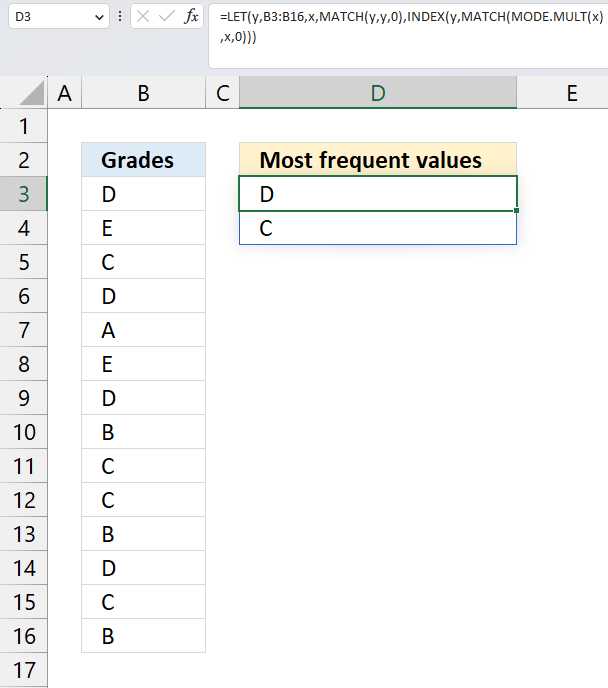
The formula in cell D3 extracts the most frequent text values from cell range B3:B16. It will return multiple text values if they are equally frequent. Cell range B3:B16 contains the following grades:
| Grades |
| D |
| E |
| C |
| D |
| A |
| E |
| D |
| B |
| C |
| C |
| B |
| D |
| C |
| B |
Excel 365 formula in cell D3:
Cell range B3:B16 contains student grades from A to E, cells D3 and D4 contain grade "D" and "C". They are equally frequent in B3:B16.
Explaining formula
The Evaluate Formula tool is located on the Formulas tab in the Ribbon. It is a useful feature that allows you to step through and evaluate complex formulas to understand how the calculation is being performed and identify any errors or issues. The following steps shows these detailed evaluations for the formula above.
Step 1 - Find relative position in the array
The MATCH function returns the relative position of an item in an array that matches a specified value in a specific order.
Function syntax: MATCH(lookup_value, lookup_array, [match_type])
MATCH(B3:B16,B3:B16,0)
becomes
MATCH({"D";"E";"C";"D";"A";"E";"D";"B";"C";"C";"B";"D";"C";"B"},{"D";"E";"C";"D";"A";"E";"D";"B";"C";"C";"B";"D";"C";"B"},0)
and returns
{1; 2; 3; 1; 5; 2; 1; 8; 3; 3; 8; 1; 3; 8}.
Step 2 - Calculate the mode
The MODE.MULT function returns the most frequent number in a cell range. It will return multiple numbers if they are equally frequent.
Function syntax: MODE.MULT((number1,[number2],...)
MODE.MULT(MATCH(B3:B16,B3:B16,0))
becomes
MODE.MULT({1; 2; 3; 1; 5; 2; 1; 8; 3; 3; 8; 1; 3; 8})
and returns
{1;3}
Step 3 - Find the position of the mode numbers in the array
The MATCH function returns the relative position of an item in an array that matches a specified value in a specific order.
Function syntax: MATCH(lookup_value, lookup_array, [match_type])
MATCH(MODE.MULT(MATCH(B3:B16,B3:B16,0)),MATCH(B3:B16,B3:B16,0),0)
becomes
MATCH({1;3},{1; 2; 3; 1; 5; 2; 1; 8; 3; 3; 8; 1; 3; 8},0)
and returns
{1;3}
Step 4 - Get text values from the corresponding positions
The INDEX function returns a value or reference from a cell range or array, you specify which value based on a row and column number.
Function syntax: INDEX(array, [row_num], [column_num])
INDEX(B3:B16,MATCH(MODE.MULT(MATCH(B3:B16,B3:B16,0)),MATCH(B3:B16,B3:B16,0),0))
becomes
INDEX(B3:B16,{1;3})
and returns
{"D";"C"}.
Step 5 - Shorten formula
The LET function lets you name intermediate calculation results which can shorten formulas considerably and improve performance.
Function syntax: LET(name1, name_value1, calculation_or_name2, [name_value2, calculation_or_name3...])
INDEX(B3:B16,MATCH(MODE.MULT(MATCH(B3:B16,B3:B16,0)),MATCH(B3:B16,B3:B16,0),0))
MATCH(B3:B16,B3:B16,0) is repeated twice.
x - MATCH(B3:B16,B3:B16,0)
B3:B16 is repeated three times.
y - B3:B16
LET(y,B3:B16,x,MATCH(y,y,0),INDEX(y,MATCH(MODE.MULT(x),x,0)))
Functions in 'Statistical' category
The MODE.MULT function function is one of 73 functions in the 'Statistical' category.
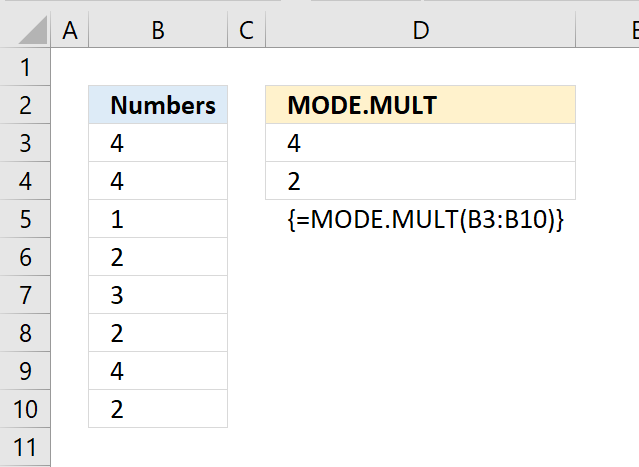
How to comment
How to add a formula to your comment
<code>Insert your formula here.</code>
Convert less than and larger than signs
Use html character entities instead of less than and larger than signs.
< becomes < and > becomes >
How to add VBA code to your comment
[vb 1="vbnet" language=","]
Put your VBA code here.
[/vb]
How to add a picture to your comment:
Upload picture to postimage.org or imgur
Paste image link to your comment.
Contact Oscar
You can contact me through this contact form